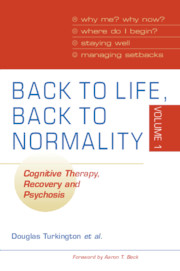Book contents
- Back to Life, Back to Normality
- Back to Life, Back to Normality
- Copyright page
- Contents
- Foreword
- Acknowledgments
- About the authors
- Introduction
- 1 Where do Ibegin? (…or so many problems, so little time!)
- 2 What is normal?
- 3 Understandingparanoia and unusual beliefs
- 4 Voices
- 5 Overcomingnegative symptoms
- 6 Tablets and injections
- 7 Why me? Why now? Understandingvulnerability from a cognitive perspective
- 8 Helpingcarers help themselves using a cognitive approach
- 9 Staying well andmanaging setbacks
- Subject Index
2 - What is normal?
Published online by Cambridge University Press: 22 September 2009
- Back to Life, Back to Normality
- Back to Life, Back to Normality
- Copyright page
- Contents
- Foreword
- Acknowledgments
- About the authors
- Introduction
- 1 Where do Ibegin? (…or so many problems, so little time!)
- 2 What is normal?
- 3 Understandingparanoia and unusual beliefs
- 4 Voices
- 5 Overcomingnegative symptoms
- 6 Tablets and injections
- 7 Why me? Why now? Understandingvulnerability from a cognitive perspective
- 8 Helpingcarers help themselves using a cognitive approach
- 9 Staying well andmanaging setbacks
- Subject Index
Summary
This chapter is an antidote to stigma. Psychiatry for many years has focused on diagnosing certain mental illnesses. But what is normality? Professor Kingdon explains that psychotic symptoms can occur in anybody and that usually they clear up quickly.
- Type
- Chapter
- Information
- Back to Life, Back to NormalityCognitive Therapy, Recovery and Psychosis, pp. 23 - 34Publisher: Cambridge University PressPrint publication year: 2009

